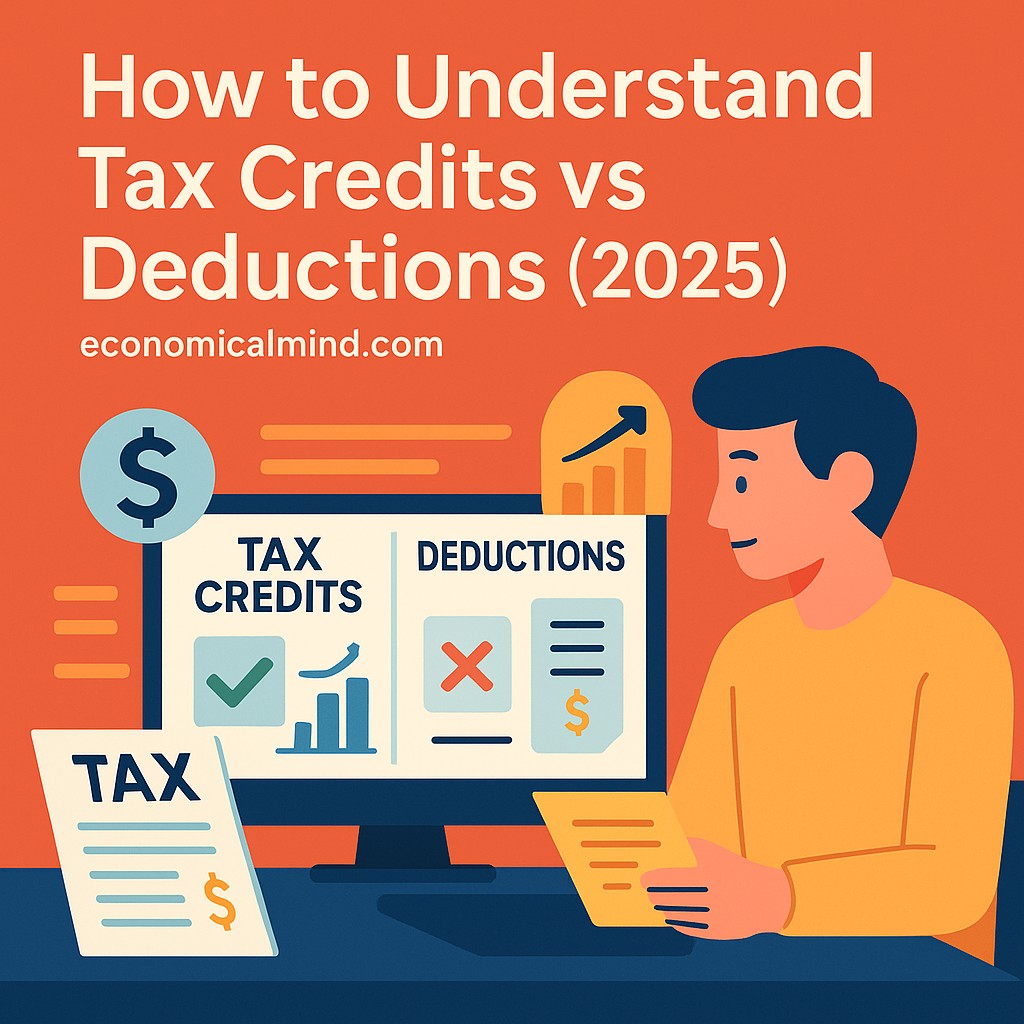
Why It’s Important to Know the Difference
When tax season arrives, most people just want to know one thing: How can I pay less?
That’s where tax credits and tax deductions come in.
Both reduce your overall tax liability — but in very different ways. Understanding how each works can save you hundreds or even thousands of dollars in 2025.
Let’s break it down in plain English.
Step 1: What Are Tax Deductions?
A tax deduction reduces the amount of your income that’s subject to tax.
Think of it this way:
If you earn $70,000 and claim $10,000 in deductions, you’re only taxed on $60,000.
Common deductions include:
- Mortgage interest
- Student loan interest
- 401(k) or IRA contributions
- Medical expenses (if itemizing)
- Charitable donations
Example:
If you’re in the 22% tax bracket, a $1,000 deduction saves you $220 in taxes (22% of $1,000).
So deductions reduce your taxable income — but their value depends on your tax bracket.
Step 2: What Are Tax Credits?
A tax credit directly reduces the amount of tax you owe — dollar for dollar.
Example:
If you owe $2,000 in taxes and qualify for a $500 credit, your new tax bill is $1,500.
Credits are more powerful than deductions because they lower your tax bill directly — not just your taxable income.
Common tax credits in 2025 include:
- Child Tax Credit: Up to $2,000 per child
- Earned Income Tax Credit (EITC): For lower- to moderate-income workers
- American Opportunity Credit: For college tuition expenses
- Energy-Efficient Home Credit: For installing solar panels or electric vehicles
- Saver’s Credit: For contributing to retirement accounts
Some credits are even refundable, meaning if the credit exceeds your total tax owed, you get the difference as a refund.
Step 3: Credits vs Deductions — Side by Side
| Feature | Tax Credit | Tax Deduction |
|---|---|---|
| Effect | Reduces tax owed directly | Reduces taxable income |
| Value | Dollar-for-dollar reduction | Value depends on tax bracket |
| Refundable? | Some credits are refundable | Never refundable |
| Examples | Child Tax Credit, EITC, Education Credits | Mortgage interest, retirement contributions |
Simple takeaway:
Credits usually save you more money than deductions of the same amount.
Step 4: Standard Deduction vs Itemized Deductions
In 2025, most taxpayers use the standard deduction because it’s higher than ever:
- $14,600 for single filers
- $29,200 for married couples filing jointly
If your deductible expenses (like mortgage interest and charitable gifts) are less than those amounts, take the standard deduction — it’s simpler and often more beneficial.
If you have large deductible expenses, you can itemize instead to maximize savings.
Step 5: How to Claim Tax Credits in 2025
Claiming tax credits depends on your eligibility and documentation.
Here’s how:
- Gather receipts, W-2s, 1098s, and 1099s.
- Use tax prep software or work with a CPA to confirm eligibility.
- File the appropriate forms — for example:
- Form 8863 for education credits
- Form 2441 for child and dependent care credits
- Form 5695 for energy credits
Pro tip: Always double-check that you qualify. Filing incorrect credits can delay your refund.
Step 6: Combine Credits and Deductions for Maximum Savings
You don’t have to choose one — the best tax strategies use both.
Example:
- You claim a $10,000 deduction for your 401(k) contributions.
- You also claim a $2,000 Child Tax Credit.
Together, these lower both your taxable income and your total tax owed — a double win for your wallet.
Step 7: Refundable vs Non-Refundable Credits
Not all credits work the same way.
- Non-refundable credits: Can reduce your tax bill to zero but not below (e.g., Child Tax Credit).
- Refundable credits: Can create a refund even if you owe no tax (e.g., Earned Income Tax Credit).
- Partially refundable credits: Offer a refund only up to a certain amount (e.g., American Opportunity Credit).
Knowing which type you qualify for helps you plan your return better.
Step 8: Tax Planning Tips for 2025
- Max out retirement contributions. Reduces taxable income and builds wealth.
- Track education expenses. Credits like the Lifetime Learning Credit can offset tuition costs.
- Claim energy incentives. Green home improvements and EV purchases often qualify for credits.
- Keep detailed records. Receipts, forms, and proof of expenses ensure smooth filing and reduce audit risk.
Step 9: Use Tools or Professionals
Tax laws evolve yearly. Using IRS-certified software (like TurboTax, H&R Block, or Cash App Taxes) or consulting a licensed tax professional ensures accuracy and maximized savings.
They’ll automatically check for new credits, deductions, and state-specific incentives that you might miss.
Final Thoughts
Understanding tax credits vs deductions in 2025 empowers you to make smarter decisions before you file.
- Credits lower what you owe directly.
- Deductions lower how much of your income is taxed.
When you combine both strategically, you keep more money in your pocket — and that’s the smartest financial move of all.
